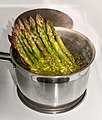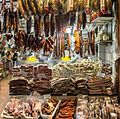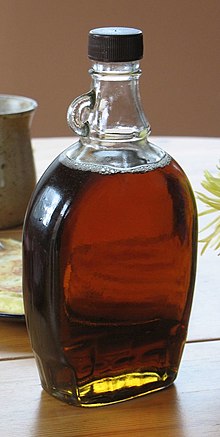F o o d
A portal dedicated to food and foodways
Introduction
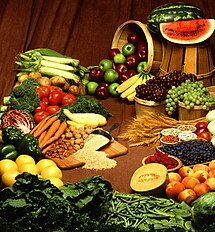
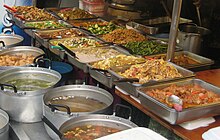
Food is any substance consumed by an organism for nutritional support. Food is usually of plant, animal, or fungal origin and contains essential nutrients such as carbohydrates, fats, proteins, vitamins, or minerals. The substance is ingested by an organism and assimilated by the organism's cells to provide energy, maintain life, or stimulate growth. Different species of animals have different feeding behaviours that satisfy the needs of their metabolisms and have evolved to fill a specific ecological niche within specific geographical contexts.
Omnivorous humans are highly adaptable and have adapted to obtain food in many different ecosystems. Humans generally use cooking to prepare food for consumption. The majority of the food energy required is supplied by the industrial food industry, which produces food through intensive agriculture and distributes it through complex food processing and food distribution systems. This system of conventional agriculture relies heavily on fossil fuels, which means that the food and agricultural systems are one of the major contributors to climate change, accounting for as much as 37% of total greenhouse gas emissions. (Full article...)
Cooking, also known as cookery or professionally as the culinary arts, is the art, science and craft of using heat to make food more palatable, digestible, nutritious, or safe. Cooking techniques and ingredients vary widely, from grilling food over an open fire, to using electric stoves, to baking in various types of ovens, reflecting local conditions. Cooking is an aspect of all human societies and a cultural universal.
Preparing food with heat or fire is an activity unique to humans. Archeological evidence of cooking fires from at least 300,000 years ago exists, but some estimate that humans started cooking up to 2 million years ago.
The expansion of agriculture, commerce, trade, and transportation between civilizations in different regions offered cooks many new ingredients. New inventions and technologies, such as the invention of pottery for holding and boiling of water, expanded cooking techniques. Some modern cooks apply advanced scientific techniques to food preparation to further enhance the flavor of the dish served. (Full article...)
Naem may refer to: (Full article...)
Selected article –
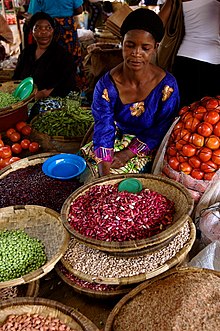
Food security is the state of having reliable access to a sufficient quantity of affordable, nutritious food. The availability of food for people of any class, gender or religion is another element of food security. Similarly, household food security is considered to exist when all the members of a family, at all times, have access to enough food for an active, healthy life. Individuals who are food-secure do not live in hunger or fear of starvation. Food security includes resilience to future disruptions of food supply. Such a disruption could occur due to various risk factors such as droughts and floods, shipping disruptions, fuel shortages, economic instability, and wars. Food insecurity is the opposite of food security: a state where there is only limited or uncertain availability of suitable food.
The concept of food security has evolved over time. The four pillars of food security include availability, access, utilization, and stability. In addition, there are two more dimensions that are important: agency and sustainability. These six dimensions of food security are reinforced in conceptual and legal understandings of the right to food. The World Food Summit in 1996 declared that "food should not be used as an instrument for political and economic pressure." (Full article...)Selected cuisine -

Italian cuisine is a Mediterranean cuisine consisting of the ingredients, recipes, and cooking techniques developed in Italy since Roman times and later spread around the world together with waves of Italian diaspora. Significant changes occurred with the colonization of the Americas and the introduction of potatoes, tomatoes, capsicums, maize, and sugar beet—the latter introduced in quantity in the 18th century. It is one of the best-known and most appreciated gastronomies worldwide.
Italian cuisine includes deeply rooted traditions common to the whole country, as well as all the regional gastronomies, different from each other, especially between the north, the centre, and the south of Italy, which are in continuous exchange. Many dishes that were once regional have proliferated with variations throughout the country. Italian cuisine offers an abundance of taste, and is one of the most popular and copied around the world. The cuisine has influenced several other cuisines around the world, chiefly that of the United States in the form of Italian-American cuisine. (Full article...)Selected ingredient –
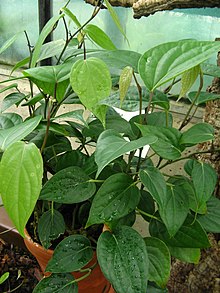
Piper cubeba, cubeb or tailed pepper is a plant in genus Piper, cultivated for its fruit and essential oil. It is mostly grown in Java and Sumatra, hence sometimes called Java pepper. The fruits are gathered before they are ripe, and carefully dried. Commercial cubeb consists of the dried berries, similar in appearance to black pepper, but with stalks attached – the "tails" in "tailed pepper". The dried pericarp is wrinkled, and its color ranges from grayish brown to black. The seed is hard, white and oily. The odor of cubeb is described as agreeable and aromatic and the taste as pungent, acrid, slightly bitter and persistent. It has been described as tasting like allspice, or like a cross between allspice and black pepper.
Cubeb came to Europe via India through the trade with the Arabs. The name cubeb comes from Arabic kabāba (كبابة) by way of Old French quibibes. Cubeb is mentioned in alchemical writings by its Arabic name. In his Theatrum Botanicum, John Parkinson tells that the king of Portugal (Possibly either Philip IV of Spain or John IV of Portugal, as that year was marked by the start of the Portuguese Restoration War) prohibited the sale of cubeb to promote black pepper (Piper nigrum) around 1640. It experienced a brief resurgence in 19th-century Europe for medicinal uses, but has practically vanished from the European market since. It continues to be used as a flavoring agent for gins and cigarettes in the West, and as a seasoning for food in Indonesia. (Full article...)
Selected recipe –
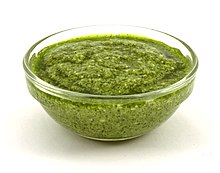
Pesto (Italian: [ˈpesto]) or more fully pesto alla genovese (Italian: [ˈpesto alla dʒenoˈveːse, -eːze]; lit. 'Genoese pesto') is a paste made of crushed garlic, pine nuts, salt, basil leaves, grated cheese such as Parmesan or pecorino sardo, and olive oil. It originated in the Italian city of Genoa, and is used to dress pasta and flavour genoese minestrone soup. (Full article...)
Maple syrup is a syrup made from the sap of maple trees. In cold climates, these trees store starch in their trunks and roots before winter; the starch is then converted to sugar that rises in the sap in late winter and early spring. Maple trees are tapped by drilling holes into their trunks and collecting the sap, which is processed by heating to evaporate much of the water, leaving the concentrated syrup.
Maple syrup was first made by the Indigenous peoples of Northeastern North America. The practice was adopted by European settlers, who gradually changed production methods. Technological improvements in the 1970s further refined syrup processing. Virtually all of the world's maple syrup is produced in Canada and the United States. The Canadian province of Quebec is the largest producer, responsible for 70 per cent of the world's output; Canadian exports of maple syrup in 2016 were C$487 million (about US$360 million), with Quebec accounting for some 90 per cent of this total. (Full article...)Selected image –
Selected biography –
B. 27 May 1975
Jamie Trevor Oliver MBE OSI (born 27 May 1975) is an English celebrity chef, restaurateur and cookbook author. He is known for his casual approach to cuisine, which has led him to front numerous television shows and open many restaurants.
Oliver reached the public eye when his series The Naked Chef premiered in 1999. In 2005, he opened a campaign, Feed Me Better, to introduce schoolchildren to healthier foods, which was later backed by the government. He was the owner of a restaurant chain, Jamie Oliver Restaurant Group, which opened its first restaurant, Jamie's Italian, in Oxford in 2008. The chain went into administration in May 2019. (Full article...)
Did you know (auto-generated) –

- ... that a two-year-old food bank contributed 150 semi-trucks of supplies to relief efforts for Hurricane Katrina?
- ... that staff at the vegan food brand VFC interact with internet trolls on social media platforms to grow their online brand?
- ... that the Ni'isjoohl totem pole was once fed a diet of vacuum-packed food?
- ... that Steven A. Shaw, one of the first food bloggers, decided to pursue the career that he loved after the early death of his father?
- ... that Turkish migrant workers living in a residential complex in Amsterdam refused to eat the Dutch food for two weeks after the kitchen's only Turkish chef was fired?
- ... that Cibo paints Italian food over neo-fascist graffiti?
More did you know –
Related portals
Food topics
The following are topics relating to food
Categories
Food list articles
- See also: Lists of foods and Category:Lists of drinks
The following are some Food list articles on Wikipedia:

- American cheeses
- Appellation d'Origine Contrôlée cheeses
- Apple cultivars
- Bacon dishes
- Bacon substitutes
- Basil cultivars
- Breads
- Breakfast beverages
- Breakfast cereals
- Breakfast foods
- British cheeses
- Cakes
- Candies
- Cheeses
- Cheese soups
- Christmas dishes (list)
- Cocktails
- Cookies
- Dishes using coconut milk
- Diets
- Doughnut varieties
- Egg dishes
- Fermented soy products
- Food additives
- Food additives (Codex Alimentarius)
- Foods named after people
- French cheeses
- French dishes
- Fried dough foods
- Fruits
- List of hamburgers
- Herbs and spices
- Hors d'oeuvre
- Indian dishes
- Indian snack foods
- Indonesian dishes
- Italian dishes
- Japanese snacks
- Japanese dishes
- Jewish dishes
- Kebabs
- Korean beverages
- Mango cultivars
- Moroccan dishes
- Pasta
- Pastries
- Philippine snack food
- Pies, tarts and flans
- Poppy seed pastries and dishes
- Potato dishes
- Puddings
- Raw fish dishes
- Rice dishes
- Rolled foods
- Sauces
- Seafood
- Seeds
- Sandwiches
- Snack foods
- Soft drinks by country
- Soul foods and dishes
- Soups
- Stews
- Street foods
- Tapas
- Turkish dishes
- Twice-baked foods
- Vegetable oils
- Vegetables
- Vodkas
Things you can do
Related WikiProjects
| Parent project: WikiProject Food and Drink | |
| Child projects: | Task forces: (All inactive) |
|
|
| Related projects: | |
New articles
Rules | Match log | Results page (for watching) | Last updated: 2024-07-29 19:20 (UTC)
Note: The list display can now be customized by each user. See List display personalization for details.
- Hy (company) (edit | talk | history | links | watch | logs | tools) by FrederickEvans (talk · contribs · new pages (109)) started on 2024-07-29, score: 20
- Masterfoods (edit | talk | history | links | watch | logs | tools) by Pidzz (talk · contribs · new pages (16)) started on 2024-07-29, score: 40
- Hydrox Corporation (edit | talk | history | links | watch | logs | tools) by Bluethricecreamman (talk · contribs · new pages (5)) started on 2024-07-29, score: 30
- Marmelada de Santa Luzia (edit | talk | history | links | watch | logs | tools) by BaduFerreira (talk · contribs · new pages (2)) started on 2024-07-28, score: 30
- Mangifera applanata (edit | talk | history | links | watch | logs | tools) by Tropwine (talk · contribs · new pages (2)) started on 2024-07-28, score: 10
- Avec (restaurant) (edit | talk | history | links | watch | logs | tools) by Another Believer (talk · contribs · new pages (77)) started on 2024-07-26, score: 10
- Oh Seung-hoon (curler) (edit | talk | history | links | watch | logs | tools) by TracyFleuryFan (talk · contribs · new pages (9)) started on 2024-07-27, score: 10
- Neary's (edit | talk | history | links | watch | logs | tools) by Voorts (talk · contribs · new pages (37)) started on 2024-07-27, score: 10
- Phin (restaurant) (edit | talk | history | links | watch | logs | tools) by Another Believer (talk · contribs · new pages (77)) started on 2024-07-27, score: 10
- Parliamentary Under-Secretary of State for Nature (edit | talk | history | links | watch | logs | tools) by THeShavidow1 (talk · contribs · new pages (14)) started on 2024-07-27, score: 10
- T. B. Robson (edit | talk | history | links | watch | logs | tools) by Doug butler (talk · contribs · new pages (22)) started on 2024-07-27, score: 10
- Nepal Foods (edit | talk | history | links | watch | logs | tools) by HibaShaikh (talk · contribs · new pages (5)) started on 2024-07-27, score: 10
- Analog Coffee (edit | talk | history | links | watch | logs | tools) by Another Believer (talk · contribs · new pages (77)) started on 2024-07-27, score: 10
- The Green Tree Distillery (edit | talk | history | links | watch | logs | tools) by MonikaKubasakova (talk · contribs · new pages (1)) started on 2024-07-27, score: 10
- Café Hagen (edit | talk | history | links | watch | logs | tools) by Another Believer (talk · contribs · new pages (77)) started on 2024-07-23, score: 10
- Mannion v. Coors Brewing Co. (edit | talk | history | links | watch | logs | tools) by Daniel Case (talk · contribs · new pages (6)) started on 2024-07-25, score: 10
- Meldon Reservoir (edit | talk | history | links | watch | logs | tools) by Owain.davies (talk · contribs · new pages (1)) started on 2024-07-24, score: 10
- Pendennis Club (cocktail) (edit | talk | history | links | watch | logs | tools) by Nbarth (talk · contribs · new pages (3)) started on 2024-07-24, score: 10
- Lewis Orford (footballer) (edit | talk | history | links | watch | logs | tools) by 86.18.110.36 (talk · contribs · new pages (1)) started on 2024-07-24, score: 10
- Hags (restaurant) (edit | talk | history | links | watch | logs | tools) by MainlyTwelve (talk · contribs · new pages (9)) started on 2024-07-23, score: 10
- Angelito Esguerra (edit | talk | history | links | watch | logs | tools) by YssaLang (talk · contribs · new pages (28)) started on 2024-07-23, score: 10
- Moon Si-woo (edit | talk | history | links | watch | logs | tools) by TracyFleuryFan (talk · contribs · new pages (9)) started on 2024-07-23, score: 10
- Kim Ji-yoon (curler) (edit | talk | history | links | watch | logs | tools) by TracyFleuryFan (talk · contribs · new pages (9)) started on 2024-07-22, score: 10
- Tavern Talk (edit | talk | history | links | watch | logs | tools) by CoffeeTalkBarista (talk · contribs · new pages (2)) started on 2024-07-21, score: 20
- Ossetian cheese (edit | talk | history | links | watch | logs | tools) by Mazdayasnah (talk · contribs · new pages (1)) started on 2024-07-16, score: 10
- Martha Brotherton (edit | talk | history | links | watch | logs | tools) by Throughthemind (talk · contribs · new pages (14)) started on 2024-07-22, score: 10
- Bellwether Bar (edit | talk | history | links | watch | logs | tools) by Another Believer (talk · contribs · new pages (77)) started on 2024-07-21, score: 10
- Candyland (Brooke Candy album) (edit | talk | history | links | watch | logs | tools) by BiggestBidder (talk · contribs · new pages (1)) started on 2024-07-21, score: 10
- Dovyalis affra (edit | talk | history | links | watch | logs | tools) by Sminthopsis84 (talk · contribs · new pages (3)) started on 2024-07-20, score: 10
- Peely (edit | talk | history | links | watch | logs | tools) by Soulbust (talk · contribs · new pages (10)) started on 2024-07-20, score: 10
- Omnivore (TV series) (edit | talk | history | links | watch | logs | tools) by Crcolas (talk · contribs · new pages (14)) started on 2024-07-20, score: 20
- Solveig Strand (edit | talk | history | links | watch | logs | tools) by Geschichte (talk · contribs · new pages (15)) started on 2024-07-20, score: 10
- Elm Coffee Roasters (edit | talk | history | links | watch | logs | tools) by Another Believer (talk · contribs · new pages (77)) started on 2024-07-20, score: 10
- Moore Coffee (edit | talk | history | links | watch | logs | tools) by Another Believer (talk · contribs · new pages (77)) started on 2024-07-19, score: 10
- Frigo (ice cream) (edit | talk | history | links | watch | logs | tools) by YuSkinsColombianos (talk · contribs · new pages (3)) started on 2024-07-12, score: 10
- Gene Camarena (edit | talk | history | links | watch | logs | tools) by Bsoyka (talk · contribs · new pages (46)) started on 2024-07-19, score: 10
- Rice paddle (edit | talk | history | links | watch | logs | tools) by MicrobiologyMarcus (talk · contribs · new pages (3)) started on 2024-07-19, score: 10
- Siŭijŏnsŏ (edit | talk | history | links | watch | logs | tools) by Ahecht (talk · contribs · new pages (46)) started on 2024-07-19, score: 10
- Franz Bock (SA-Obergruppenführer) (edit | talk | history | links | watch | logs | tools) by Historybuff0105 (talk · contribs · new pages (9)) started on 2024-07-18, score: 10
- List of grass jelly plants (edit | talk | history | links | watch | logs | tools) by Awkwafaba (talk · contribs · new pages (78)) started on 2024-07-11, score: 10
- Tennessee Alcoholic Beverage Commission (edit | talk | history | links | watch | logs | tools) by Dmoore5556 (talk · contribs · new pages (9)) started on 2024-07-18, score: 10
- Mississippi Office of Alcoholic Beverage Control (edit | talk | history | links | watch | logs | tools) by Dmoore5556 (talk · contribs · new pages (9)) started on 2024-07-17, score: 10
- Michael Mosley (edit | talk | history | links | watch | logs | tools) by SafariScribe (talk · contribs · new pages (199)) started on 2024-07-17, score: 10
- La Grande Maison Paris (edit | talk | history | links | watch | logs | tools) by Yut3117 (talk · contribs · new pages (3)) started on 2024-07-17, score: 20
- Mattoni 1873 (edit | talk | history | links | watch | logs | tools) by Revirvlkodlaku (talk · contribs · new pages (2)) started on 2024-07-17, score: 10
- Honeydew honey (edit | talk | history | links | watch | logs | tools) by Fgnievinski (talk · contribs · new pages (15)) started on 2024-07-17, score: 10
- Más+ (edit | talk | history | links | watch | logs | tools) by Bennett1203 (talk · contribs · new pages (4)) started on 2024-07-16, score: 30
- Los Gorditos (edit | talk | history | links | watch | logs | tools) by Another Believer (talk · contribs · new pages (77)) started on 2024-07-16, score: 10
- Ahluwalia (caste) (edit | talk | history | links | watch | logs | tools) by Liz (talk · contribs · new pages (23)) started on 2024-07-16, score: 10
- Costello's (edit | talk | history | links | watch | logs | tools) by Voorts (talk · contribs · new pages (37)) started on 2024-07-12, score: 10
- White sauce (Virginia) (edit | talk | history | links | watch | logs | tools) by Bookworm-ce (talk · contribs · new pages (10)) started on 2024-07-16, score: 30
- Barista Coffee (Taiwan) (edit | talk | history | links | watch | logs | tools) by Heeheemalu (talk · contribs · new pages (5)) started on 2024-07-16, score: 30
- Cama Café (edit | talk | history | links | watch | logs | tools) by Heeheemalu (talk · contribs · new pages (5)) started on 2024-07-16, score: 30
- Dante Coffee (edit | talk | history | links | watch | logs | tools) by Heeheemalu (talk · contribs · new pages (5)) started on 2024-07-16, score: 30
- Nielsen's Frozen Custard (edit | talk | history | links | watch | logs | tools) by DarkNight0917 (talk · contribs · new pages (4)) started on 2024-07-16, score: 20
- Milo's Tea Company (edit | talk | history | links | watch | logs | tools) by DarkNight0917 (talk · contribs · new pages (4)) started on 2024-07-15, score: 20
- Scooter's Coffee (edit | talk | history | links | watch | logs | tools) by TCMemoire (talk · contribs · new pages (44)) started on 2024-07-15, score: 20
- Top Coffee bombing (edit | talk | history | links | watch | logs | tools) by QalasQalas (talk · contribs · new pages (8)) started on 2024-07-15, score: 10
- Top Cafe bombing (edit | talk | history | links | watch | logs | tools) by QalasQalas (talk · contribs · new pages (8)) started on 2024-07-15, score: 10
- Fairlie Bakehouse (edit | talk | history | links | watch | logs | tools) by Cloventt (talk · contribs · new pages (1)) started on 2024-07-15, score: 20
Associated Wikimedia
The following Wikimedia Foundation sister projects provide more on this subject:
-
Commons
Free media repository -
Wikibooks
Free textbooks and manuals -
Wikidata
Free knowledge base -
Wikinews
Free-content news -
Wikiquote
Collection of quotations -
Wikisource
Free-content library -
Wikiversity
Free learning tools -
Wiktionary
Dictionary and thesaurus
